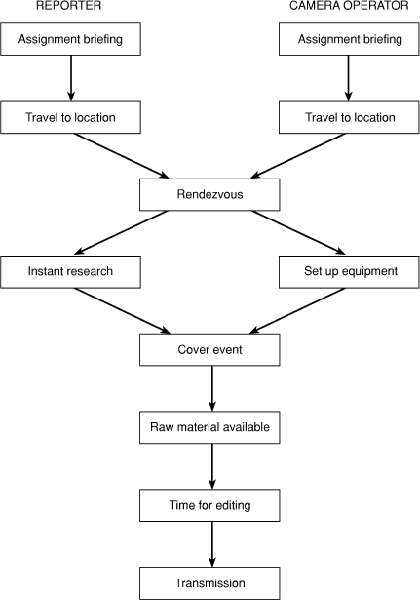The Reporter as Manager
As we approach the end of the century, a team working on location for a typical news programme is likely to consist of no more than two people — a reporter and a camera-operator. Until the single ‘video-journalist’ becomes an industry standard, knowing how to be an effective leader will remain an integral part of the reporter’s job. Being in charge of the camera-operator usually goes with editorial responsibility for the story. Strong-willed professionals inevitably have differences of opinion from time to time, making ‘management’ a daunting prospect, but even as a newcomer you must always be assertive, take the lead and set the pace. At all times know what you want: inexperienced or freelance camera crews will expect to follow your instructions, sometimes to the letter.
Reporter-camera operator relationship
Because every television report should be the result of a combination of creative processes, a positive working relationship between reporter and camera-operator is far more likely to produce successful results than one in which the two are at odds with each other. In some circumstances how far you are united in your determination to pursue a news story could make the difference between life and death.
Trust and interdependability work both ways. Nothing damns a reporter more quickly in the eyes of the camera-operator than arrogance and unreliability, especially a failure to get to a location on time. Remember, too, how important it is to keep the camera-operator informed. Say clearly what you expect, and although it is not necessary to know the technical details of every piece of equipment, a rudimentary understanding of and interest in how things work will contribute towards telling the story more effectively.
Meeting deadlines
Before satellites and microwave links became commonplace, news programmes relied on more basic forms of communication to ensure their raw material reached base in time for editing and transmission. The principle, if not the method, remains the same. Deadlines have shrunk, increasing pressure on the team in the field to plan their mission down to the finest detail. Calculations about the time needed to travel to and from the scene of a story, to gather the pictures and judge their worth, to shape the material on the spot or send the raw rushes to be edited at home base, plus a safety margin, have to be built into the schedule if programme requirements are to be met.
The whole process has been speeded up with the introduction of satellite news-gathering facilities and mobile edit suites, but the ability to control the logistical problems involved in reporting is valued almost as much as straight-forward editorial talent.

Managing a news story
Whatever the assignment you must make a conscious effort to ensure all stages are completed so the material is ready to be broadcast by the programme for which it is intended. Allow sufficient leeway for your raw ‘rushes’ to be edited at base or assembled on the spot for ‘live’ transmission. Always build in a safety margin, especially abroad: it often takes longer to process the material than it does to gather it.
